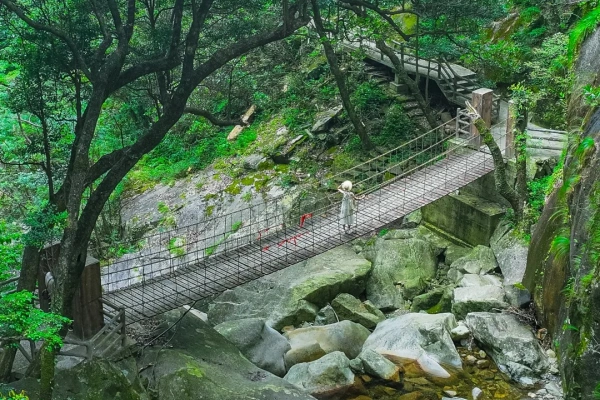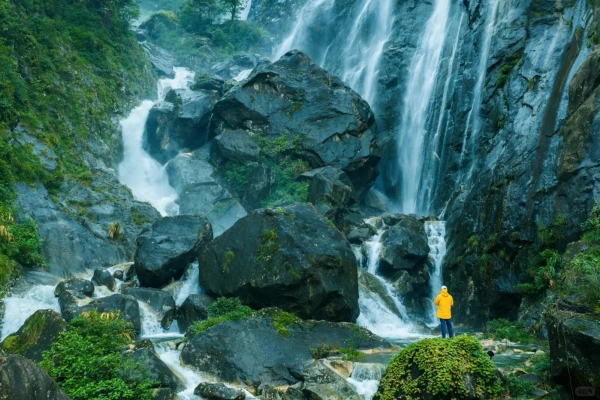Wolonggu Valley
Historical Background
Wolonggu Valley’s history dates back millions of years, shaped by tectonic movements and glacial activity that carved its dramatic cliffs and deep gorges. The valley’s name, meaning "Crouching Dragon Valley," is inspired by local legends and the winding shape of its terrain, resembling a dragon resting among the mountains. Historically, it served as a retreat for Taoist hermits and scholars seeking inspiration in nature. In recent decades, conservation efforts have focused on preserving its ecological balance while promoting sustainable tourism.
Geological Features
The valley’s landscape is dominated by towering limestone cliffs, ancient rock formations, and lush valleys formed over eons. Notable features include the "Dragon’s Backbone," a jagged ridge that stretches for kilometers, and the "Silver Waterfall," which plunges 80 meters into a crystal-clear pool below. The area is also home to unique karst caves, some of which contain prehistoric fossils and stalactites. Geologists study the valley to understand Earth’s ancient climate and tectonic shifts.

Flora And Fauna
Wolonggu Valley boasts a rich biodiversity, with over 1,000 plant species, including rare orchids, ginkgo trees, and medicinal herbs. Its forests provide habitat for endangered animals such as the Asian golden cat, Reeves’s pheasant, and the Chinese giant salamander. Birdwatchers flock to the valley to spot species like the crested serpent eagle and the red-billed blue magpie. Conservation programs protect these species, while educational signs educate visitors on the importance of ecological preservation.
Major Attractions
Key highlights include the "Heavenly Lake," a serene alpine lake surrounded by pine forests, and the "Stone Forest," a maze of weathered rock pillars. The "Dragon’s Gate" trail offers panoramic views of the valley, while the "Hidden Temple" ruins hint at the area’s spiritual past. For adventure seekers, the valley features zip lines, rock-climbing routes, and guided night hikes to observe nocturnal wildlife. Seasonal events, like autumn foliage festivals, draw crowds to witness the valley’s vibrant colors.
Hiking Trails
Wolonggu Valley offers trails for all skill levels, from gentle riverside paths to challenging mountain ascents. The "Main Loop Trail" (8 km) winds through bamboo groves and past waterfalls, taking 3–4 hours to complete. For experienced hikers, the "Summit Trail" (12 km) leads to the valley’s highest peak, offering 360-degree views. Trail maps are available at the visitor center, and rangers provide safety tips. Many routes intersect, allowing customizable day trips.
Visitor Facilities
The valley’s entrance features a modern visitor center with exhibits on local ecology and history, a café, and a gift shop selling handmade crafts. Well-marked rest areas with benches and picnic spots are scattered throughout the trails. Guided tours, available in English and Chinese, explore the valley’s cultural and natural heritage. Nearby, eco-friendly lodges offer rustic accommodations, while campsites cater to outdoor enthusiasts. A medical station ensures visitor safety.

Travel Tips
Best Time to Visit: Spring (April–June) and autumn (September–November) offer mild weather and vibrant scenery. Avoid summer monsoons and winter snows if hiking.
Getting There: From Luoyang city, take a local bus or taxi to the valley entrance (1.5-hour drive). Private tours often include transportation and a guide.
Essentials: Wear sturdy hiking boots, carry water, and apply sunscreen. Insect repellent is recommended in warmer months. Respect wildlife by staying on trails and not littering.
Photography: Early mornings and late afternoons provide the best light for capturing the valley’s dramatic landscapes. Drone use is restricted in protected areas.
What Our Clients Say?
Based on 10,000+ traveler reviews













